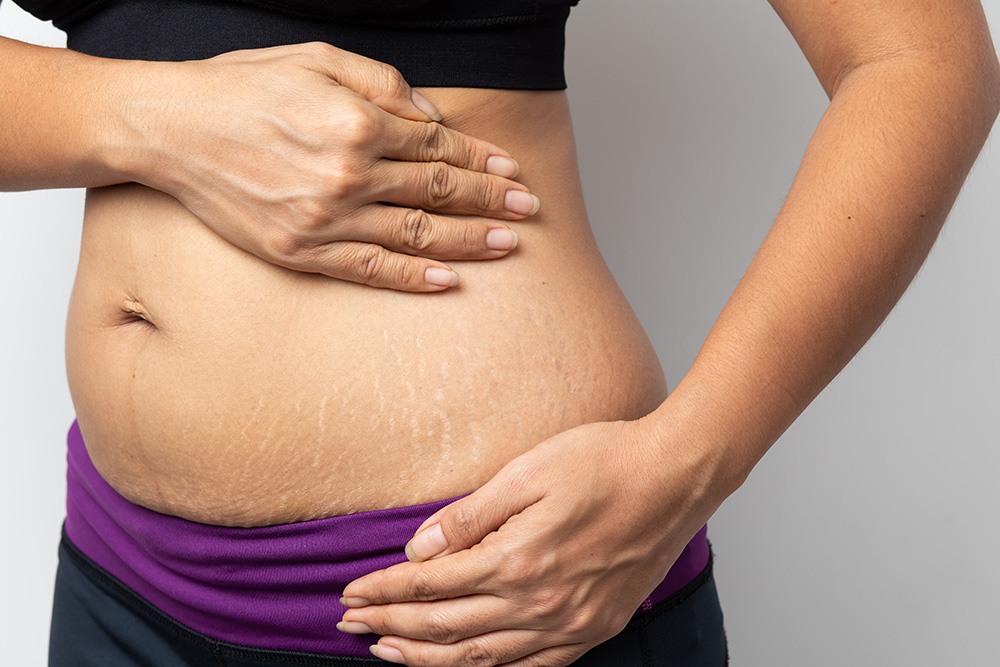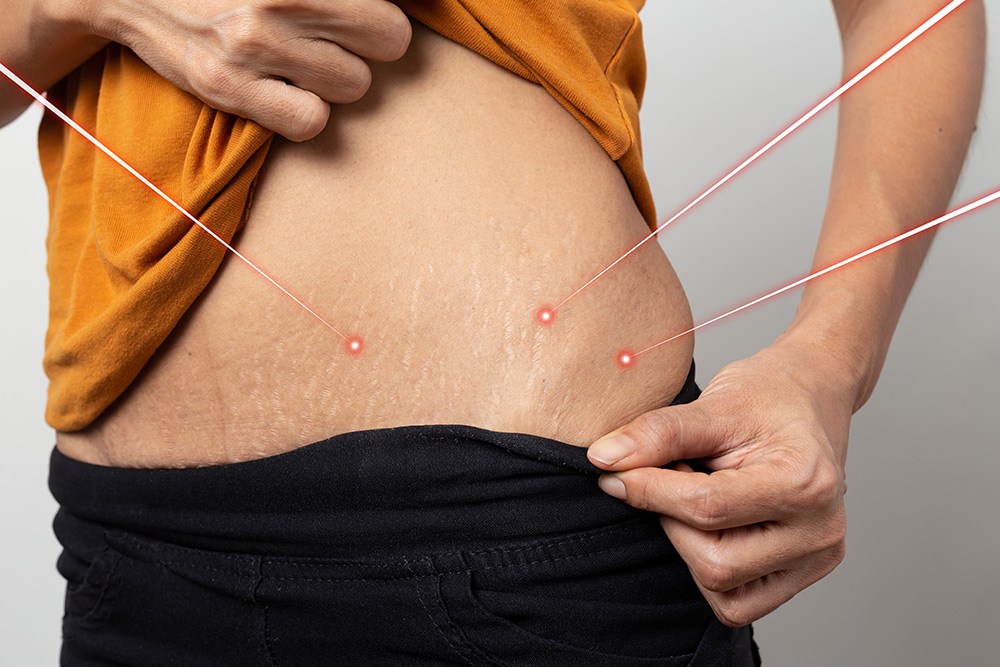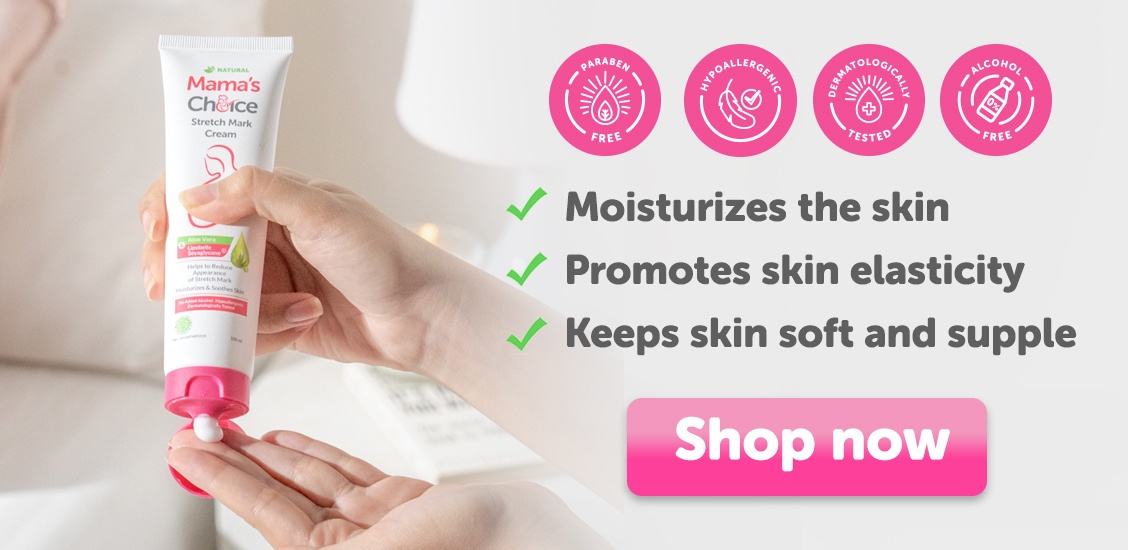What are stretch marks, and why do these battle wounds of pregnancy appear? Let’s find out!
Table of Contents
What causes stretch marks?
Who is most likely to develop stretch marks?
Where do stretch marks appear, and how long do they stay?
What can I do to get rid of them?
What can I do to prevent them?
What should you look for in a stretch mark product?
Skip ahead to any section you find the most interesting!
Stretch marks, which appear as lines on the skin, are often dubbed as a battle wound of pregnancy. In an article published on Parents.com, dermatologist Debra Jaliman, M.D. highlighted that nine out of 10 women develop stretch marks during pregnancy.
While it is indeed more common in pregnancy, anybody can get a stretch mark.
But first, what is a stretch mark? Also known as striae distensae and striae gravidarum, it’s a type of scar that appears as lines on the skin. They come in various colors depending on your skin tone and how long they’ve been around. Newer stretch marks are usually pink, red, or purple, while older stretch marks appear white or light grey.
If you wonder what causes them, how to prevent them, and what you can do about them once you spot them on your body, you’ve come to the right place, Mama.
What Are The Causes Of Stretch Marks?
A stretch mark is an aftermath of the rapid stretching or shrinking of the skin’s connective tissue, which can happen during pregnancy, weight loss, muscle building, and even growth spurts.
This sudden change leads to the tearing of collagen and elastin in our skin. Through these tears, the blood vessels underneath can show through, which leaves the red marks—one of the common colors of new stretch marks.
According to the American Pregnancy Association (APA), the development of stretch marks usually come in three stages:
- Stage 1: New stretch marks will appear pink. They may be itchy. The surrounding skin of the stretch mark will look flattened.
- Stage 2: The stretch marks will get longer and more prominent and transition into darker colors like red or purple.
- Stage 3: Mature stretch marks will no longer appear red or purple. Instead, they will look white or light gray. The lines will be noticeably more irregular in shape.
Who Is Most Likely To Develop Stretch Marks?
There’s no individual immune to developing stretch marks. From pregnant women to adult men, anybody may develop stretch marks through the course of their lifetime. However, certain risk factors make it more susceptible to specific individuals.
1. Pregnant Mamas
Of course, pregnant women are on top of the list because of the inevitable expansion of their bellies as their babies grow. Moreover, the hormonal changes Mamas go through also play a key role in weakening the skin’s connective tissues and making them more vulnerable to ruptures. They have an even higher likelihood of getting stretch marks if they gain more weight than the average or recommended weight gain.
2. Individuals with dry skin
A healthy, moisturized skin is more resilient to changes in your body. Meanwhile, having dry skin means it’s thinner, less elastic, and pliable. If you’re not moisturizing your skin regularly, you have a higher chance of developing stretch marks.
3. Individuals with stretch marks in their family history
A quick look at your family history can help you determine if you will develop stretch marks. If you’re mama, grandmother, aunt, or sister have stretch marks, then you will most likely have them too.
4. Bodybuilders
Stretch marks know no gender, as even men are troubled by them, more so if they’re bodybuilders or an avid weightlifter. With how quickly their muscles develop, it’s inevitable for their skin to stretch and scar.
5. Individuals with certain medication conditions
Cushing’s syndrome and Marfan’s syndrome are two disorders that are associated with stretch marks. This is because these two conditions affect the adrenal glands, which cause the body to release excessive cortisone levels. And with high cortisone levels comes a decrease in collagen levels in the skin.
6. Individuals frequently using corticosteroids
Corticosteroid creams, which are often used to reduce rashes, dermatitis, itching, and more, can also impact one’s susceptibility to stretch marks. This is because corticosteroids can lower collagen levels in the skin and reduce your skin’s elasticity.
Where Do Stretch Marks Appear And How Long Do They Stay?
Some common areas where stretch marks appear include the abdomen, breasts, thighs, hips, lower back, and buttocks. The APA stressed that they are “more likely to appear in places where large amounts of fat are stored.” For weightlifters and bodybuilders, the arms, thighs, and buttocks are where they usually appear.
Medical News Today reports that stretch marks typically become less noticeable 6 to 12 months postpartum for pregnant Mamas.
What Can You Do To Get Rid Of Stretch Marks?
Stretch marks often fade over time. But of course, not everyone has the patience or luxury of time to wait for them to go away. Thankfully, there are a few clinical treatments to help get rid of them. Here’s how can you reduce their appearance
or get rid of them entirely.
1. Microdermabrasion
A fast and painless procedure, it works by targeting the top layer of the skin to remove dead skin. A single treatment is usually not enough, so you may need to come back for more sessions to achieve your desired result.
2. Laser therapy
Although it’s a treatment more commonly done for acne scars, laser therapy can also target these pregnancy battle scars. It works by using laser light to trigger melanin production so that they will blend in with your skin tone.
3. Micro-needling
With micro-needling, tiny needles are used to trigger collagen production. Similar to microdermabrasion, one treatment is not enough to get rid of them. Studies have shown that micro-needling is particularly effective for patients with darker skin tones as well.
4. Chemical peels
A chemical peel has been known to reduce the appearance of stretch marks, particularly white ones. Similar to other treatments, a chemical peel stimulates collagen production.
5. Cosmetic surgery
If all else fails, one can opt for cosmetic surgery. Not only is this treatment pricey, but it also comes with its own set of health risks.
Here’s one thing to remember though: newer stretch marks, which appear pink, purple, or red-like, are generally easier to treat compared with the whiter and more mature stretch marks.
How Do You Prevent Stretch Marks?
It’s great that there are a variety of treatment options for stretch marks. But frankly, they can get pretty expensive. Fret not, though, as there are numerous ways to make sure that we prevent these pregnancy battle scars from showing up.
1. Moisturize your skin
As mentioned earlier, dry skin makes you more prone to stretch marks. Pay attention to your skincare routine and ensure that you’re giving it some TLC. Use a lotion or, better yet, a product that’s specially formulated for stretch mark prevention.
2. Exercise regularly
There’s a lot of perks to exercising when you’re pregnant. Not only does it give you more energy and improve your mood, but it also improves circulation, which then helps keep your skin elastic. The APA furthers that pregnancy exercise can also reduce “the possibility of varicose veins and swollen ankles.”
3. Eat skin-healthy food
In tandem with regular exercise, eating healthy food also does wonders for your skin. In particular, incorporate more fruits and vegetables rich in vitamins E, C, B2, B3, zinc, and silica. Drinking enough water is also crucial in maintaining healthy skin.
4. Control your pregnancy weight gain
The American College of Obstetricians and Gynecologists recommend women at a healthy weight to gain somewhere between 25-35 pounds. Meanwhile, those who are underweight are advised to gain up to 40 pounds. Those who are overweight, only 15-25 pounds.
5. Avoid direct sunlight
As we all know, UV rays can damage the skin’s collagen. If you’re going out, use a mineral sunscreen or a pregnancy-safe moisturizer with SPF.
What Should You Look For In A Stretch Mark Product?
Pregnancy makes one prone to stretch marks, which is why a stretch mark product is all the more critical. However, since pregnancy is a susceptible period, one must be cautious about looking for a stretch mark cream.
With some chemicals capable of harming a fetus, it’s best to steer clear of products that contain retinoids, salicylic acid in high dosages, phthalates, hydroquinone, formaldehyde, parabens, and chemical sunscreens.
Apart from these ingredients that you should avoid, several tried-and-tested ingredients do wonders to help with stretch marks. These include:
- Shea Butter
- Jojoba Oil
- Aloe Vera
- Cocoa
- Vitamins A & E
- Hyaluronic Acid
- Coconut Oil
- Argan Oil
- Rosehip Oil
Keep Stretch Marks At Bay With Mama’s Choice Stretch Mark Cream
When it comes to stretch marks, it’s always better to prevent them from appearing regardless of your genetics. Just like what Benjamin Franklin said, “An ounce of prevention is worth a pound of cure.”
Mama’s Choice Stretch Mark Cream is here to help Mamas protect their skin from stretch marks and reduce their appearance. Enriched with a blend of natural ingredients known to target stretch marks such as aloe vera, shea butter, and the incredible Lipobelle™ Soyaglicone, which is derived from soy.
Together, our natural ingredients help moisturize your skin, protect it from damage, and naturally enhance collagen production for improved elasticity. Plus, it helps relieve itching, too!
We also took an extra step to ensure it’s 100% safe for you and your little one. Our stretch mark cream is free of paraben and alcohol and dermatologically tested in Singapore. How do you make the most of our stretch mark cream? By applying it generously all over your body, even from the first trimester.
Now that you know a little more about stretch marks do yourself a favor and keep your skin free of stretch marks with Mama’s Choice Stretch Mark Cream. 😉
Mama's Choice Team
A team of passionate writers, young mamas, and creative superheroes who help mamas face motherhood one educational article at a time!












